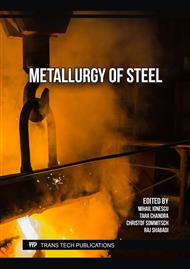[1]
L.Å. Norström and O. Vingsbo, "Influence of Nickel on Toughness and Ductile-Brittle Transition in Low-Carbon Martensite Steels," Metal Science, vol. 13, no. 12, pp.677-684, 1979
DOI: 10.1179/030634579790434321
Google Scholar
[2]
R. Abrahams, "Low Alloy High Performance Steel," United States Patent 10,450,621 B2, Oct. 2019. Table 2 - Summary of Alloy Mechanical Properties in the Tempered Condition and Prior Austenite Grain Size (PAGS) Alloy Quench HRC YS (MPa) UTS (MPa) CVN RT (J) CVN -40 °C (J) PAGS (μm) Base BQ 49 ± 0.6 1248 ± 8 1550 ± 7 55 ± 5 28 ± 1 36.2 ± 2.1* OQ 48 ± 0.5 1211 ± 1 1542 ± 1 35 ± 1 25 ± 1 Base +Mo BQ 50 ± 0.3 1297 ± 7 1596 ± 9 54 ± 1 41 ± 3 15.1 ± 1.1 OQ 49 ± 0.3 1211 ± 1 1542 ± 1 52 ± 2 39 ± 2 Base +MoV BQ 50 ± 0.4 1340 ± 11 1655 ± 12 48 ± 1 33 ± 2 14.5 ± 1.0 OQ 52 ± 0.3 1318 ± 3 1665 ± 8 41 ± 4 35 ± 5
Google Scholar
[3]
Matsuda, H.; Mizuno, R.; Funakawa, Y.; Seto, K.; Matsuoka, S.; Tanaka, Y. Effects of AutoTempering Behaviour of Martensite on Properties of Ultra High Strength Steel Sheets. J. Alloys Compd. 2013, 577.
DOI: 10.1016/j.jallcom.2012.04.108
Google Scholar
[4]
Li, C.N.; Yuan, G.; Ji, F.Q.; Ren, D.S.; Wang, G.D. Effects of Auto-tempering on Microstructure and Mechanical Properties in Hot Rolled Plain C-Mn Dual Phase Steels. Mater. Sci. Eng. A 2016, 665, 98-107.
DOI: 10.1016/j.msea.2016.04.038
Google Scholar
[5]
Z. Luo et al., "Effect of Substructure on Toughness of Lath Martensite/Bainite Mixed Structure in Low-Carbon Steels," Journal of Iron and Steel Research International, vol. 17, no. 11, pp.40-48, 2010.
DOI: 10.1016/s1006-706x(10)60168-9
Google Scholar
[6]
K. Abbaszadeh, H. Saghafian, and S. Kheirandish, "Effect of Bainite Morphology on Mechanical Properties of the Mixed Bainite-Martensite Microstructure in D6AC Steel," Journal of Materials Science & Technology, vol. 28, no. 4, pp.336-342, 2012.
DOI: 10.1016/s1005-0302(12)60065-6
Google Scholar
[7]
L. J. Leach, C. W. Siyasiya, and W. E. Stumpf, "Effect of dual phase microstructure on the toughness of a Cr-Mo low-alloy plate steel," The Journal of The Southern African Institute of Mining and Metallurgy, vol. 113, pp.109-113, Feb. 2013.
Google Scholar
[8]
T. Alurakami, Y. Imai, I. Nakajima, "The Effect of Alloying Elements on the Austenitic Grain Size and its Growth of Steel" Journal of the Japan Institute of Metals, vol. 7, no. 8, pp.336-346, 1943.
DOI: 10.2320/jinstmet1937.7.8_336
Google Scholar
[9]
K. Irvine and F. Pickering, "The Tempering Characteristics of Low-Carbon Low-Alloy Steels," Journal of the Iron and Steel Institute, vol. 194, pp.137-153, 1960.
Google Scholar
[10]
R. A. Grange, C. R. Hribal, and L. F. Porter, "Hardness of Tempered Martensite in Carbon and Low-Alloy Steels," Metallurgical Transactions A, vol. 8, pp.1775-1785, 1977.
DOI: 10.1007/bf02646882
Google Scholar
[11]
E. C. Bain, Functions of the Alloying Elements in Steel. Cleveland, OH: ASM, pp.144-312, 1952.
Google Scholar
[12]
G. R. Speich and W. C. Leslie, "Tempering of steel," Metallurgical Transactions, vol. 3, no. 5, pp.1043-1054, May 1972.
DOI: 10.1007/bf02642436
Google Scholar
[13]
H. K. D. H. Bhadeshia and R. W. K. Honeycombe, "Tempering of Steel," in Steels: Microstructure and Properties, Amsterdam: Butterworth-Heineman, 2017, pp.237-263.
DOI: 10.1016/b978-0-08-100270-4.00009-3
Google Scholar
[14]
A. Allten and P. Payson, "The Effect of Silicon on the Tempering of Martensite," Transactions of the American Society for Metals, vol. 45, pp.498-525, 1953.
Google Scholar
[15]
W.-J. Nam and H.-C. Choi, "Effects of Silicon, Nickel, and Vanadium on Impact Toughness in Spring Steels," Materials Science and Technology, vol. 13, no. 7, pp.568-574, 1997.
DOI: 10.1179/mst.1997.13.7.568
Google Scholar
[16]
E. Damm, "Unpublished Research", TimkenSteel, 2019.
Google Scholar
[17]
C.F. Jatczak, Hardenability of Carbon and Alloy Steels, Properties and Selection: Irons and Steels, Vol 1, Metals Handbook, 9th ed., American Society for Metals, 1978, pp.471-526.
Google Scholar
[18]
J. Wang, C. Enloe, J. Singh, and C. Horvath, "Effect of Prior Austenite Grain Size on Impact Toughness of Press Hardened Steel," SAE International Journal of Materials and Manufacturing, vol. 9, no. 2, pp.488-493, 2016.
DOI: 10.4271/2016-01-0359
Google Scholar
[19]
Morris, J. W. Jr, Kinney, C., Pytlewski, Ken & Adachi., Y. Microstructure and Cleavage in Lath Martensitic Steels. Sci. Technol. Adv. Mat. 14(1), 014208-014217 (2013).
DOI: 10.1088/1468-6996/14/1/014208
Google Scholar
[20]
J.W. Morris, Stronger, Tougher Steels, Science, 320 (2008), pp.1022-1023
DOI: 10.1126/science.1158994
Google Scholar



